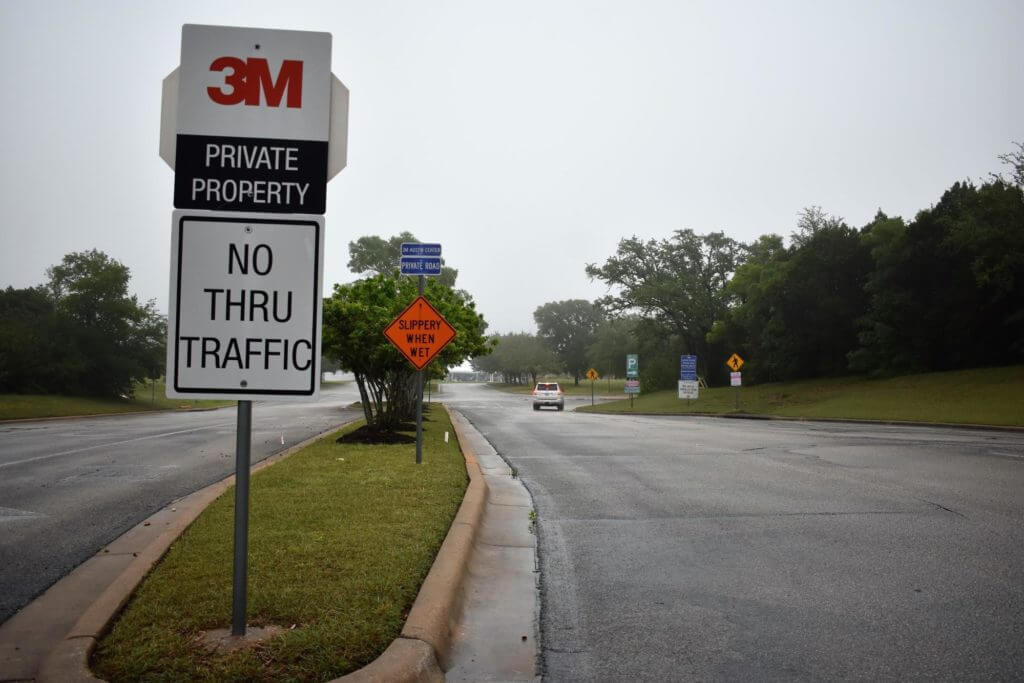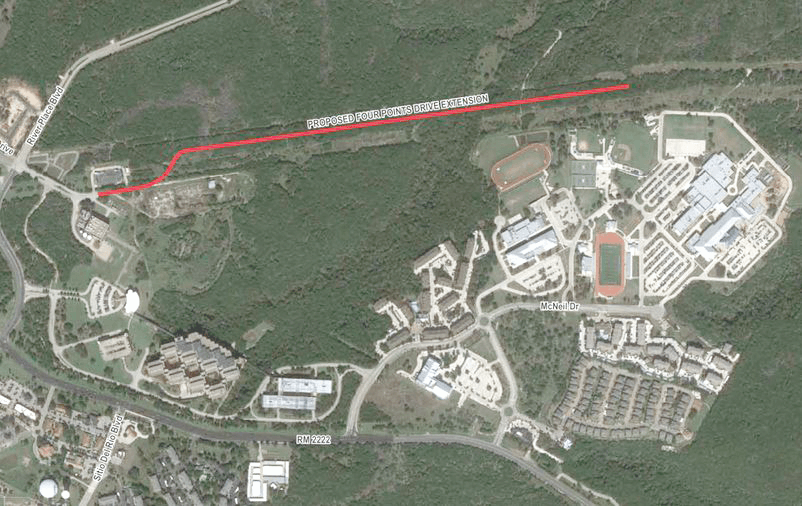By LESLEE BASSMAN, Four Points News

The city of Austin’s new plan for a secondary road from Vandegrift is expected to move forward after the 3M campus turns over in late summer. Meanwhile, Leander ISD continues to push for the same road it has been working on since 2012 in the back of the Vandegrift campus, through a utility easement within preserve land.
Following last month’s passage by Austin City Council of a transportation plan that includes a secondary road from Vandegrift and Four Points Middle School, Council Member Jimmy Flannigan weighed in on the nuances of the new campus access. He amended the city’s Strategic Mobility Plan to add the roadway — running parallel to RM 2222 and connecting McNeil Road to Four Points Drive/River Place Boulevard — on April 11, and the plan was approved unanimously by City Council.
The plan may also further connect to the new bypass road now under construction, Flannigan said.
Located at 9500 McNeil Dr., Leander ISD’s Vandegrift adjoins the same tract as Four Points MS, at the heart of the Four Points community. The complex has only one exit — onto RM 2222, an often congested roadway.
Unlike other proposals to gain a second access road in the area, the Austin City Council measure doesn’t traverse federal preserve land, instead using existing routes through the former 3M property at 6801 River Place Blvd.
“This is one of the reasons why cities are responsible for building roads,” Flannigan said. “We have more tools at our disposal which means we can be more creative about how we look for solutions and how we can actually plan and pay for these solutions.”
He said the Austin City Council often deals with rezoning requests in which the city requires the developer construct a road in the context of the process. That common practice sparked Flannigan’s idea for the access road to be designated through the former 3M tract.
Executives of 3M, a company that manufactures a variety of products including tape, notepads and packaging, announced in August 2016 that it was selling its Four Points location. World Class Property Co. agreed in 2017 to purchase the campus.
“The moment I saw the 3M property go up for sale, right before I got elected in 2016, the first thing I did was send a text message to Mayor Adler and I said, ‘dude, we can build that road,’” Flannigan said. “I was thinking about it as the most natural location.”
He said the new owner didn’t seem to be in a big rush to redevelop the campus so Flannigan found there was time to really think through the process of this accessway solution.
“Knowing that road could get done during a zoning case, I had been biding my time, waiting for a zoning case thinking it may be several years away,” he said.
As the city began to construct its Austin Strategic Mobility Plan, Flannigan said he was presented with a city map, including Four Points, and decided “it’s time to draw some lines.”
He also said the drawing depicting the road’s location isn’t an engineered document but rather a placeholder for the access point.
“The ASMP (Austin Strategic Mobility Plan) is really more about showing connectivity and not about specifically what square inch (the road) will go,” Flannigan said.
Flannigan received the support of his colleagues for the idea, including District 10 Council Member Alison Alter, who covers the area of the former 3M plant, and District 7 Council Member Leslie Pool, who chairs the Balcones Canyonland Conservation Plan Coordinating Committee.
One of the biggest factors in the popularity of the proposal was that the area designated for the access is already paved and isn’t preserve land, Flannigan said.
Timeline
The roadway section that connects to the bypass road is “far less likely” to advance as is the section connecting McNeil to Four Points/River Place since staffers with the Texas Department of Transportation — the agency building the bypass road — told Flannigan that section’s engineering documents are already complete, he said.
The bypass road has always been a TxDOT project and not a city project even though Austin’s coffers partially funded it, Flannigan said.
“The segment that goes from McNeil to Four Points is really just a matter of when it redevelops,” he said. “So as 3M exits, whatever goes in there — you look around the area and you think some retail, maybe some multifamily (housing) — they have to come in for a zoning case because the zoning that site has right now is (Research & Development) zoning. It’s not very good zoning for what we know will end up being there.”
Flannigan said, even if the access road was not required by the city during a rezoning process, Austin could still require the road’s development at the stage when the city confirms the project site plan is in compliance with local regulations.
However, during the time 3M still occupies the site, its executives won’t allow outside traffic within its campus, he said.
“Once 3M has exited and the property is empty, then we can start entertaining different types of conversations with the property owner than we can’t have now,” Flannigan said.
According to 3M spokesperson Stephen Sanchez, the company is going through a multiphase move-out process of its River Place Boulevard campus, with most employees exiting in June. He said the keys will be turned over to the new owner at the end of August.
The future Vandegrift High School access road, as with all Austin Strategic Mobility Plan projects, is not yet funded, Flannigan said.
“What’s nice about this (ASMP project), specifically the segment from McNeil to Four Points, is because it seems very clear that that is part of a future redevelopment, the funding comes from the developer,” Flannigan said. “So the city doesn’t have to come in and build the road just as the developer built all the roads in Steiner Ranch and they built all the roads in River Place.”
LISD simultaneously pursuing original secondary road
Since 2012, LISD staff and board of trustees, together with local residents and the Four Points Traffic Committee, have been fighting to get a secondary access road through the property. However, the school complex is surrounded by the Balcones Canyonland Preserve, protected land requiring federal action to enable the project to come to fruition.
District officials said, despite the plan approved by Austin City Council, they are still pursuing the original route, of which a small portion traverses through a designated infrastructure corridor in the Balcones Canyonland Preserve.
According to Jimmy Disler, the district’s chief facilities and operations officer, LISD is currently awaiting a response to a permit application filed with U.S. Fish & Wildlife Service in December that would move the project forward.
“At this time, our application (for the original secondary access road from Vandegrift High School) is still being reviewed by U.S. Fish & Wildlife,” Disler told Four Points News. “A call (is planned) between the district and all parties in the next week to discuss the application.”
Corey Ryan, LISD chief communications officer, added that this process is still within the window of what the district anticipated to be a response time from the federal agency.
Mary Elder, the assistant regional director of external affairs for the Southwest Region of U.S. Fish and Wildlife Service, said her department “do(es)n’t have any updates to provide at this time.”
Superintendent of Schools Dan Troxell stated in an email that the district is “encouraged by and appreciative of the City of Austin and Councilman Jimmy Flannigan for adding a project to the Austin Strategic Mobility Plan to address traffic congestion on the Vandegrift and Four Points campuses.”
“The road the city proposes is a good project to create an additional access point onto and off of our campuses,” Troxell stated. “Due to the safety needs for emergency vehicles to access the campus from (RM) 620 and for traffic congestion relief on FM 2222, we will continue to pursue all access routes to ensure the safety of students, teachers, staff and families.”
Morgan Briscoe, president of the West Austin Chamber of Commerce, said this secondary road through the 3M property was previously discussed as part of the Four Points Task Force — a joint effort with area citizens, the West Austin Chamber of Commerce and Flannigan’s office.
“All parties involved were of the belief that a second entrance to Vandergrift is needed for safety measures,” Briscoe said.
Community response
Flannigan said residents “are very excited” about the project and want to see it move forward, sooner rather than later.
“Mostly it’s excitement to see a solution to see something that seems more likely if only because it’s proposed by a jurisdiction that typically is responsible for roads,” he said.
Besides asking about the project’s timeline, Flannigan said he has been responding to residents’ questions about its efficacy, or how effective this solution will be for the area’s traffic and congestion.
“It doesn’t solve that second half of the bottleneck, between McNeil and the campus, but there are other options there that we can consider,” Flannigan said. “What everyone universally agrees is that this additional road connection that parallels (RM) 2222 can only help.”
He said there are some folks who are concerned about the route’s proximity to the Balcones Canyonland Preserve and water quality due to runoff. Flannigan said he reminds those constituents that “this area is already paved and the school traffic is already there.”
“This is not the kind of road you build because you’re going to build a whole new development,” he said. “The development’s coming and the school traffic’s already there. Some of those issues about inducing more traffic when you build more roads do not apply in this site because it’s already there and the pavement is already poured.”
Briscoe said her group is hopeful that additional access to Vandegrift, along with other corridor safety and mobility improvements such as the TxDOT bypass road, will “help increase roadway flow and reduce accidents.”
“A standstill of our local roadways greatly impacts people’s decision making and behavior,” she said. “We often hear people talking about what they will and won’t do according to times and traffic. Traffic slowdowns equal business slowdowns when people can’t get to their offices, stores, appointments and meetings.”
The area still needs other transportation improvements including additional sidewalk and crossing options, better commuter transportation choices and additional roadway capacity — projects that Briscoe hopes will be added to the Austin Strategic Mobility Plan and transportation agency agendas “to increase traffic and productivity to the area.”



